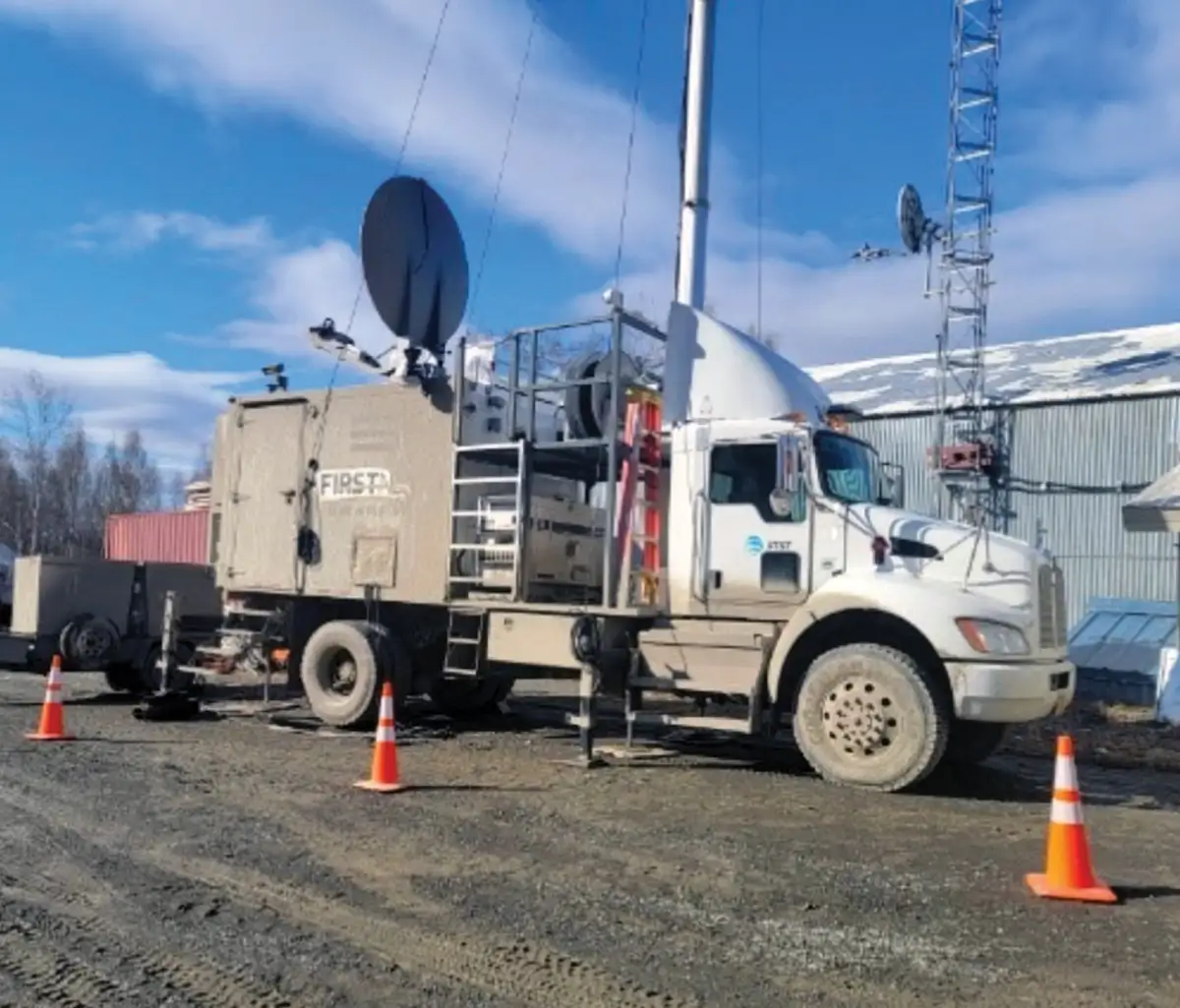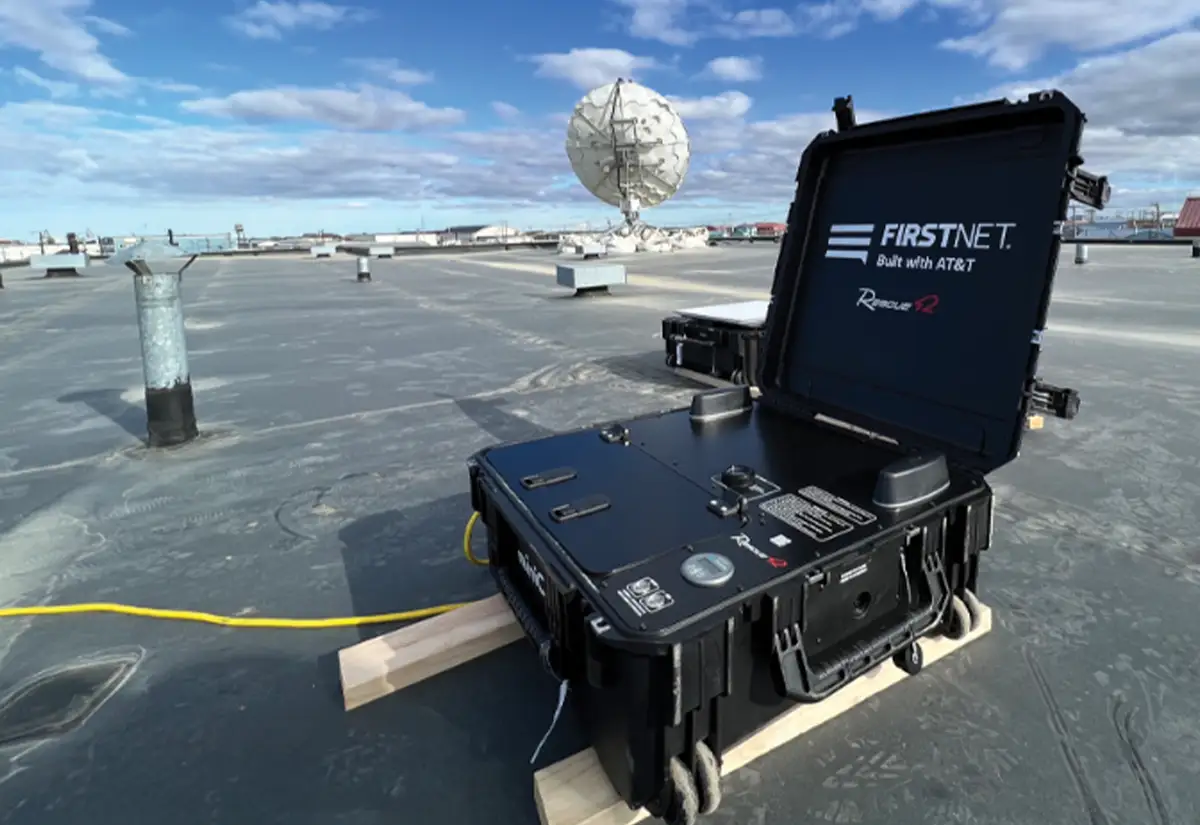By Tracy Barbour
or two weeks last August, Sitka’s internet went dark. A fiber optic cable on the floor of Salisbury Sound failed, and it took sixteen days to repair. A survey by the Sitka Economic Development Association found that businesses reported losing transactions worth thousands of dollars each day. Nearly one-third of respondents said they switched from GCI to a satellite-based service because of the disruption. It was the second time in eight years that Sitka’s only broadband cable broke.
Satellite internet also received a boost last year when communities along the Arctic Ocean lost their broadband connections. Sea ice scouring along the seabed cut Quintillion’s cable northwest of Prudhoe Bay. Until a repair vessel was able to splice the damage, the region’s data pipeline was severed for more than two months.
These are the types of emergencies that put telecommunications companies’ contingency plans to the test. “In both cases, we were able to restore internet service to our customers within a few days by deploying satellite solutions that leverage GEO and LEO stations,” says Tony Dodge, vice president of network planning at Alaska Communications. GEO refers to geostationary equatorial orbit, and LEO is the broader category of low-Earth orbit, a region that has been packed in the last five years with more than 7,000 satellites launched by Starlink, a subsidiary of SpaceX.
Microcom

A backup tool specifically for public safety agencies is AT&T’s FirstNet Response Operations Group. The team led by former first responders mobilized during the 2023 outage to prioritize critical services such as hospitals, fire stations, dispatchers, and air ambulances to ensure first responders could communicate with one another. “Thanks to these efforts, first responders in towns like Utqiaġvik, Wainwright, and Point Hope had the dedicated connectivity to stay mission ready,” says Elizabeth Songvilay, director of external and legislative affairs for AT&T in Hawai’i and Alaska.
AT&T also deployed emergency communications portable units in the wake of the Sitka cable break and, in October, a deadly landslide in Ketchikan.
AT&T, Pacific Dataport, Alaska Communications, and other providers play a crucial role in ensuring connectivity during outages caused by technical failures, weather conditions, natural disasters, and other disruptions. They employ a range of technologies to aid affected communities during emergencies.
Microcom

The first live TV downlink in Alaska, the lunar landing in 1969, arrived at a then-new facility in the foothills of the Talkeetna Mountains. Owned since 2019 by Anchorage-based Microcom, Talkeetna Alaska Teleport is the gateway for Microcom’s spinoff, Pacific Dataport, which has a partnership to provide services through Eutelsat OneWeb’s orbital broadband network of 634 satellites.
Microcom


The first live TV downlink in Alaska, the lunar landing in 1969, arrived at a then-new facility in the foothills of the Talkeetna Mountains. Owned since 2019 by Anchorage-based Microcom, Talkeetna Alaska Teleport is the gateway for Microcom’s spinoff, Pacific Dataport, which has a partnership to provide services through Eutelsat OneWeb’s orbital broadband network of 634 satellites.
Microcom
Where connectivity has been unreliable or completely unavailable, broadband via satellite has become an alternative. In fact, that’s a key objective of Starlink, which “aims to enable anyone impacted by a natural disaster to access internet connectivity,” according to its website. Putting that pledge into action, Starlink offered free internet service in southeastern states affected by Hurricane Helene and Hurricane Milton until the end of 2024.
Personal and business customers can choose from a variety of Starlink service plans, generally available with unlimited data and no monthly contracts. There are fixed-rate and mobile plans for residential customers as well as maritime, aviation, and business plans. Customers can access Starlink’s service with equipment that they can purchase from the company’s website and authorized retailers like Microcom, Best Buy, or Home Depot. They can install the equipment themselves—using instructions listed on Starlink’s website—or pay a third party like Microcom to perform the installation.
Pacific Dataport partners closely with its sister company Microcom to rapidly deploy space-based satellite services throughout Alaska. Thanks to Microcom’s strong statewide installation capabilities and a team of nearly 100 skilled employees, the company can efficiently tackle all connectivity challenges, Williams says. He elaborates, “In Anchorage, we keep terminals and installation supplies in our warehouse, so we’re ready at a moment’s notice.”
Its ability to distribute both Eutelsat OneWeb and Starlink services in Alaska is a significant advantage, and the next phase is broadband from the Aurora 4A satellite, launched last April to a geosynchronous slot above Bethel, exclusively to serve Alaska.
“The utilization of low-Earth-orbit satellite solutions can greatly mitigate the impact of terrestrial network outages by providing rapid deployment and connectivity restoration,” Williams explains. “This is particularly crucial for remote communities that rely heavily on communication networks for essential services.”
By having agreements and infrastructure in place beforehand, providers can switch to satellite networks almost instantly, minimizing downtime. “Unfortunately, not all providers have such contingency plans in place, which can lead to prolonged outages affecting both individuals and critical services,” Williams says.
Integrating backup solutions into broader disaster preparedness initiatives would enhance telecommunications resilience across Alaska. “For example, incorporating them into the state’s Natural Hazard Threat Assessment and Mitigation Plan for the Alaska Broadband Office’s Broadband Equity, Access, and Deployment (BEAD) Program can promote proactive planning among providers, just as they do in the Lower 48,” Williams says. “This alignment would encourage the adoption of backup networks as a standard practice, enhancing overall network reliability for all Alaskans.”
The more complex the network, the more reasons for internet outages—but there are just as many ways to approach restoration. “For MTA, emergencies are considered network outages, and all network outages are considered emergencies no matter the scale—be it large or small,” says Gary Enloe, vice president of network engineering planning and operations for the Palmer-based cooperative. “Some are indeed more urgent than others, especially when emergency services are involved.”
Outage prevention, mitigation, and restoration are always included in the design, building, operations, and maintenance of MTA networks, Enloe says. Some key preventive practices include strict equipment installation policies and procedures; keeping hardware and software up to date; following strict policies and procedures for equipment additions, upgrades, and removals; setting up proper alarms and monitoring; and having vendor support plans in place and a team dedicated to cybersecurity. MTA also designs as many redundancies into the network as economically and physically feasible.



AT&T
Clear and timely updates are part of MTA’s response during emergencies like the 2019 McKinley wildfire.
MTA


AT&T

Clear and timely updates are part of MTA’s response during emergencies like the 2019 McKinley wildfire.
MTA
“Depending on the type, size, and complexity of a network outage, we use a comprehensive emergency restoration plan,” Enloe explains. “The plan is a detailed set of instructions and procedures that is usually used in association with natural disasters or extreme weather events.”
For instance, MTA rapidly executed a restoration plan in 2019 when the McKinley wildfire destroyed thousands of acres north of Willow and nearly 100 structures—including an MTA site. “After it was safe to enter the site, MTA teams used our mobile Switch-On-Wheels to configure new electronics, replace burned sections of cables, and restore services by approximately within 24 hours,” Enloe says. “The restoration timeframe was, in reality, less than a day because MTA needed to wait several hours for the fire to recede and the site to cool down before technicians could safely enter the area to begin repairs.”
“In the event of an outage on one portion of the network, traffic would be automatically rerouted to other portions of the network to eliminate any service impact to customers,” Dodge explains. “For hard-to-reach communities where redundancy is limited, we leverage relationships with our carrier partners and alternative satellite providers to restore connections. These are generally easily configurable solutions that take place within our existing facilities.”
As part of its contingency planning, Alaska Communications has established commercial relationships with a diverse mix of satellite and wireless service providers so it can immediately access connectivity solutions to address prolonged outages to local communities. “We are also consistently reviewing alternative service providers and new technology solutions to enhance our coverage options in the event of an outage,” Dodge says.
AT&T maintains comprehensive contingency plans for providing alternative internet options in Alaska to help both public safety and commercial customers stay connected during prolonged outages. Public safety agencies on FirstNet have access to a dedicated fleet of deployable network assets stationed in several locations across the state. “In Alaska, we have equipment such as satellite solutions and generators strategically positioned for deployment when needed,” says Songvilay.
In addition, AT&T’s Network Disaster Recovery support team is prepared to deploy as needed to help restore commercial service to customers. Songvilay explains, “We can dispatch Satellite Cell on Light Trucks and Mini Compact Rapid Deployables to provide coverage in areas where terrestrial service is unavailable, and generators also play a vital role in keeping cell towers operational during power outages that may impact service.”
While FirstNet’s dedicated assets in Alaska primarily connect first responders, they also provide 911 service to commercial customers—even if their primary carrier’s cell coverage is unavailable. “Our strategy aims to keep both public safety and commercial communications operational, maintaining the essential connections needed during critical times,” Songvilay says.
AT&T is invested in its networks and the people and local communities in Alaska, Songvilay says. Between 2019 and 2023, the company invested nearly $250 million in its network infrastructure within the state. And it recently announced enhancements that have more than doubled network capacity in Southeast communities like Juneau and Skagway.
“We look forward to many more projects ahead in Alaska, especially as we enter the next phase of FirstNet reinvestments,” Songvilay says. “With the input from public safety in Alaska and investments from the FirstNet Authority, we will be expanding and enhancing coverage in the state, focusing on tribal, territorial, and rural areas.”